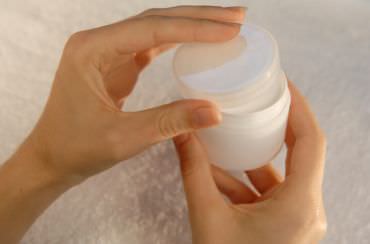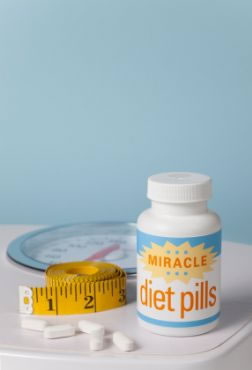|
More than 2/3 of Americans are overweight or obese (source), and we spend more than $40 billion a year on weight loss, much of it on pills, gadgets, and creams that don't live up to their lofty claims. When you're desperate to change your life, and you're just starting out, it's hard to know what's truth and what's hype. Everything sounds like the secret to losing weight, finding happiness, and becoming your best you! Late-night infomercials boast major fat burning with stunning before-and-after photos. Magazine ads claim that a pricey cream is key to flat abs. Celebrities tout shoes that promise a tighter, more toned posterior just by walking! Sounds too good to be true, right? That's because it usually is. You already know 12 Ways to Spot a Fad Diet, but the latest scams go beyond mere dieting. We asked our experts to weigh in on the year's worst diet rip-offs. Find out how to avoid falling for slick marketing ploys--before you spend any money. When it comes to weight loss, the #1 rule is: If it sounds too good to be true, it is!  Rip-Off #1: Toning shoes and clothesToning shoes claim to have an uneven, unstable sole that mimics balancing on a wobbleboard. Each brand and style is different, and many major shoe companies offer at least one style of the shoes, from sandals and sneakers to clogs. The shoes' unique soles and extra cushioning purport to force the muscles to work harder as you walk. The wearer's abs, glutes and legs "tone up" as they compensate for the unsteady sole, thus leading to an increased calorie burn, advocates say. Several reputable shoe companies have sponsored studies of their products (most of the studies are not peer-reviewed, it should be pointed out) that claim that these shoes led to increased weight loss and greater toning. Toning clothes have tiny resistance bands sewn into them, which force the body to work harder with every step. The clothing restricts movement slightly, and the slim fit is intended to make the wearer appear thinner. One study did find that wearing resistance tights while walking on a treadmill burned more calories-- but only when walking uphill. Research on this clothing (which can range from $50 to upwards of $200 per piece) is limited, but much of what we read about this clothing warned that such clothing could do more harm than good--either by restricting circulation or interfering with natural movement—and that the supposed benefits are probably very small. Our expert says: "These products are marketed as if they are able to help women tone their legs and butt, but we know that losing weight from a specific area of the body (known as “spot training”) is NOT possible. The only studies that cited the shoes' benefits were about muscle activation—not long-term safety, actual increases in strength or actual increased muscle tone or weight loss—and the studies were very small, short-lived and conducted and/or funded by the companies selling the products. My expert opinion is that the advertisements for these shoes were very misleading to consumers, and that they were never proven either safe or effective at doing anything more than changing the way you walk mildly, which may change the way your muscles activate in the short term. "That is not the same thing as weight loss or toning the legs, and it’s unlikely that the 'novelty' of a minimal increase in muscle activation will provide any tangible results in one’s body. That the FTC is now after these manufacturers for deceptive advertising should tell you for sure that they do not do what they claim." – Coach Nicole Nichols, certified personal trainer, group fitness instructor and health educator Money saved: $50-$200  Rip-off #2: Slim-down creams and lotionsOrange peel thighs. Cottage cheese legs. Flabby bellies. Long after you've lost the weight, the cellulite and loose skin sticks around for many. Rather than consider them badges of honor, memories of where we've been, we try everything we can to get rid of them--including rubbing on pricey creams and lotions that boast the ability to smooth and tighten skin--and reduce the appearance of cellulite, which is simply subcutaneous (below the skin) fat that is pushed to the surface. Many of these creams, which can be found at drug stores, in fancy department stores and online, boast caffeine or one of its derivatives as its miracle ingredient. There is no magic fat-burning ingredient, caffeine included, but the same chemical that gives your coffee its jolt can have a temporary diuretic effect on your skin and increase blood flow to the area where it was applied, thus making it appear smoother and tighter--but only for a short time and not enough to suddenly cause you to lose inches or unwanted pounds. The cellulite is still there, and when the diuretic effect wears off, your skin will return to "normal"--cellulite and all. The FTC has singled out one manufacturer for false advertising, and others have been under scrutiny by the media as well. (Test your knowledge about cellulite.) Our expert says: "Because cellulite is fat, losing weight (if you are overweight) may help diminish the appearance of cellulite as the size of your fat cells decrease. There is no way to 'spot train' any area of the body. Cardio exercise helps burn fat from all over the body and enhances fat loss. Strength training is important for both weight loss and overall health as well, but simply targeting the areas of your cellulite (hamstrings, buttocks, or abs for example) will not make it go away. "Many people can lose weight and notice an improved appearance in cellulite, but it's no guarantee. Because it's so closely linked to factors that you can't control (genetics, gender, hormones), losing weight may not completely get rid of cellulite. "Creams, treatments, massage techniques, and other cellulite therapies do NOT get rid of cellulite. While some products may help diminish the appearance of it through hydration or firming of the outer layers of the skin, these results are temporary won't result in actual fat loss." -- Coach Nicole Nichols, certified personal trainer, group fitness instructor and health educator Money saved: $15-$100+  Rip-off #3: Body wrapsLose inches overnight--no exercise needed! Slim down by the weekend, without lifting a finger!Body wraps are all the rage these days, and when you read those lofty claims, you can understand why. They sound more like a spa treatment than a part of a healthy weight-loss plan. Made of natural or synthetic cloths that are applied to various body areas for hours (or even days), these body wraps claim to reduce the size of the body parts to which they are applied. One company claims: "Expect 'ultimate' results with this amazing 45-minute body wrap! The wrap is infused with a powerful, botanically-based formula to deliver maximum tightening, toning, and firming results where applied to the skin." Experts discredit the claims that the wraps can result in fat loss. Sure, you can moisturize your skin with these wraps, and you might lose some water weight from sweating, but that's only temporary. Those claims of losing pounds are likely a result of dehydration, experts say. Our expert says: "Did you know that the human body can hold five to six pounds of water? We've all struggled with annoying 'water weight' gain from time to time, for various reasons: menstruation or hormonal changes, too much salty food, medications, or edema chief among them. While these pounds certainly count when you hop on the scale, they are temporary--and they're the weight that you lose when you suddenly shed large amounts of weight. When you use a body wrap, the lost inches are either a result of sweating or the redistribution of fluids to other parts of the body. "And remember that just as you can't 'spot-tone' one particular body part, you also can't shed weight from one part of the body at a time." -- Tanya Jolliffe, nutrition expert Money saved: $20-$450 per wrap  Rip-off #4: Acai berry, hoodia and other exotic supplements or food additivesLose 20 pounds in 2 days with hoodia! |
More From SparkPeople
|

















.jpg)